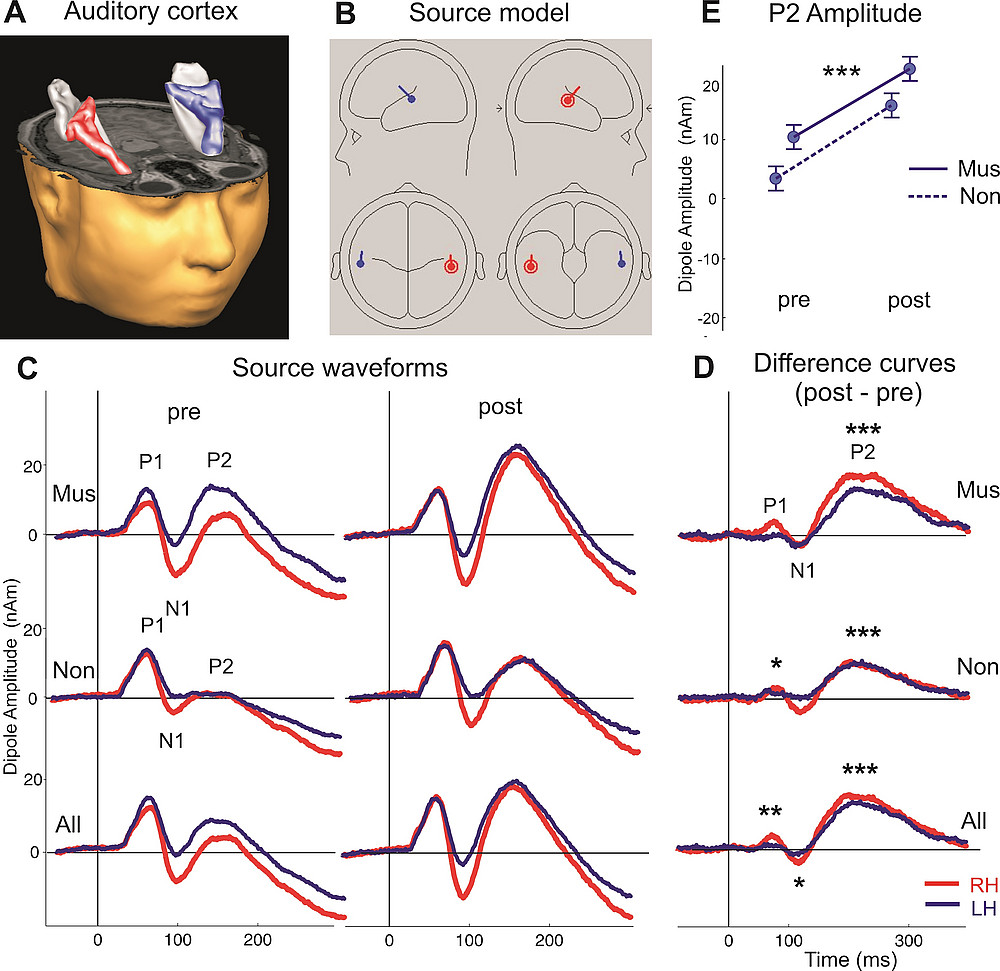AULOS listening training
With the AULOS training, we focus on the short-term plasticity of subjective auditory perception and neural information processing. It has been demonstrated that this training promotes the maturation of the auditory system in children and adolescents.
With our well-established AULOS training ("Active IndividUalized Listening OptimizationS"), we focus on the auditory and neural short-term plasticity of active listening. This research is conducted in a dedicated listening room (Fig. 1), where we refine our methods to enhance auditory processing and support cognitive and linguistic development in children.
The auditory training uses specially processed music and nature sounds delivered through headphones, speakers, and bone conduction (body sound) to promote relaxed yet active listening, selective attention, and concentration. Various filtering techniques help train focused listening in social environments and the ability to filter out irrelevant information.
Our research findings and experience so far indicate that the training reduces hearing deficits (tinnitus, hyperacousis, hearing loss) and helps counteract developmental and learning disorders. The AULOS training is based on the original concept of Audio-Psycho-Phonology by Alfred Tomatis and has been further developed and scientifically evaluated through our own neuropsychological research since 2019.

In our study "Short-term plasticity of neuro-auditory processing induced by musical active listening training" (Schneider, Seither-Preisler et al., 2022), we conducted a 20-hour AULOS listening training with a sample of 37 adolescents (20 musicians, 17 non-musicians). Using magnetoencephalography (MEG) and psychoacoustic tests, we investigated short-term plasticity in auditory-evoked fields in the brain and hearing ability in a pre-post design. Neuroplastic changes were observed in both hemispheres, with more pronounced effects in the right auditory cortex. Specifically, significant synchronization effects of auditory-evoked responses in both hemispheres were found, along with a threefold increase in the amplitude of the late P2 response, which is a marker of higher integrative auditory processing. The brain-level effects were comparable to those observed after several years of long-term musical training (Schneider & Seither-Preisler et al., 2023).

Fig. 2:
(A) Three-dimensional reconstructions of the right and left auditory cortex of an adolescent.
(B) Two-dipole model for extracting individual source waveforms (activation over time) in the regions of the left (blue) and right (red) auditory cortex.
(C) Averaged source waveforms of musicians (top), non-musicians (middle), and all participants (bottom) before (pre) and after (post) the two-week listening training.
(D) Difference curves for the pre- and post-training measurements.
(E) Increase in P2 amplitude after training. *p < 0.05; ** p < 0.01; ***p < 0.001.
Additionally, auditory discrimination performance and hearing thresholds improved significantly through the AULOS training (Fig. 3).

Fig. 3: Short-term plasticity of auditory abilities.
(A)-(F): The ability to distinguish frequencies, intensities, tone onsets (soft vs. hard), and rhythms improved significantly (*p < 0.05; ** p < 0.01; ***p < 0.001; musicians: filled circles, non-musicians: open circles).
(G) Averaged hearing thresholds for all participants. Notably, after the training, the average bone conduction thresholds improved by um 10-15 dB (10 dB corresponds to a doubling of subjective loudness) and air conduction by 3-4 dB.
(H) Absolute difference between pre- and post-training measurements for bone conduction (red) and air conduction (blue).
(I) Absolute difference between air and bone conduction for the pre-training (solid line) and post-training (dashed line) measurements.
The results suggest a strong positive influence of the active listening training on neural information processing and subjective auditory perception during adolescence, a period when the auditory system is still developing (Schneider & Seither-Preisler et al., 2023). We continuously test and optimize the AULOS training across various target groups. Currently, our PhD student Bettina Zeidler is investigating its effects on communication, language, and hearing-related abilities, as well as on social interaction in children with autism spectrum disorder. In the future, we aim to systematically study its impact on children and adolescents with the neurodevelopmental disorders ADHD, ADD and dyslexia. Additionally, training sessions with experienced musicians are planned to explore whether this method can also be used to enhance musical skills.
References
Schneider, P., Engelmann, D., Groß, C., Bernhofs, V., Hofmann, E., Christiner, M., […] & Seither-Preisler, A. (2023). Neuroanatomical disposition, natural development, and training-induced plasticity of the human auditory system from childhood to adulthood: a 12-year study in musicians and nonmusicians. Journal of Neuroscience, 43(37), 6430-6446.
Schneider, P., Groß, C., Bernhofs, V., Christiner, M., Benner, J., Turker, S., […] & Seither‐Preisler, A. (2022). Short‐term plasticity of neuro‐auditory processing induced by musical active listening training. Annals of the New York Academy of Sciences, 1517(1), 176-190. https://doi.org/10.1111/nyas.14899